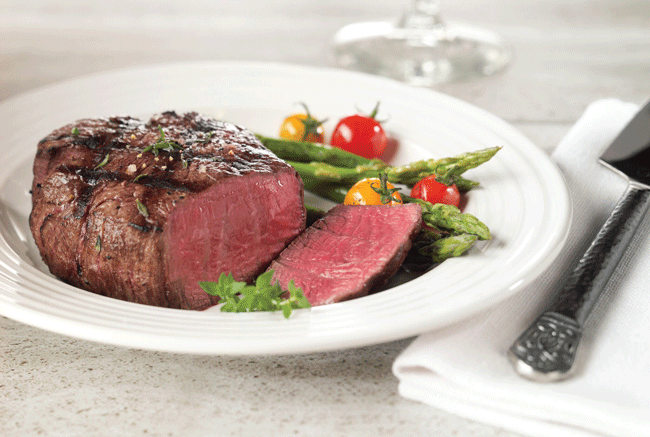Getting to the Meat of the Matter on Wagyu Beef
Posted by estiator at 15 February, at 19 : 16 PM Print
Separating the Hype from the Truth
For a few years now, food trends have been coming fast and furious, fueled to some extent by the pervasiveness of cooking shows on network and cable television, but also by social media, whose primary purpose can sometimes seem to be the sharing of recipes. And because these trends come so fast and furious, it’s easy for details to be obscured—and it’s easy for our knowledge of those trends to be crafted by salespersons or marketers eager to promote and profit from the “next big thing”.
Wagyu beef is one of those trends that seem to confuse restaurateurs and consumers alike. Although it’s not a new phenomenon, the growing availability of Wagyu and its increasing showings on menus around the country beg the need to better understand what it’s all about, particularly in light of the many myths surrounding the product.

Wagyu beef is becoming popular on American menus, but are all of the restaurants that advertise Wagyu giving the same quality?
What is Wagyu; What is Kobe?
To start, the term Wagyu is a literal translation from Japanese meaning “Japanese cow.” As such, all beef coming from Japan is considered Wagyu, drawing comparisons to much-hyped Kobe beef. Because true Kobe beef comes from Japanese cattle, all Kobe is, by definition, Wagyu. However, to be considered Kobe in Japan, the beef must come from a specific breed of cattle that are raised in a particular region of Japan, and according to specific, rigid standards. There are only 3,000 head of Kobe cattle each year and most, if not all, are kept for domestic consumption. A Kobe steak can cost upwards of $200 in Japan. So, then, how did Cheesecake Factory, in one of its many menu iterations, include a Kobe burger on its menu? Well, quite obviously it wasn’t true Kobe beef from Japan.
As of mid-2016, true Kobe beef was sold in only nine restaurants in the United States, despite the hundreds that boasted Kobe on their menus. Because there are no regulations in the United States that define Kobe beef, marketing people have used the term as they wish. And the same generally goes for Wagyu.
Keeping It Straight
Wagyu refers to four native Japanese breeds: Japanese Black, Japanese Brown, Japanese Shorthorn, and Japanese Polled cattle. But what we find in the United States is not necessarily Wagyu from Japan. To confuse matters, there is something called “American Wagyu.” In 1975, Wagyu cattle were first brought from Japan with the import of two black and two brown bulls. More came in ensuing years, and from the beginning, American ranchers have been crossbreeding the imported Japanese bulls with their own domestic cattle, usually Black Angus.
If there is no rule with how the Kobe label is applied, there are some standards that the industry loosely follows with regard to how the Wagyu label is used. According to the U.S. Department of Agriculture, a cow must be at least 50 percent Wagyu to be considered Wagyu. Policing a cow’s lineage, however, isn’t so easy. The American Wagyu Association (AWA), which is dedicated to the promotion of Wagyu beef in the United States and is made up of American Wagyu producers, serves as the primary registrar, so, it would seem, the industry pretty much regulates itself.
To confuse matters further, the AWA uses three designations with regard to domestically raised Wagyu: 100% Wagyu, Purebred Wagyu, and Percentage Wagyu. Only 100% Wagyu is from pure bloodlines, whereas Purebred Wagyu allows for some crossbreeding, and Percentage Wagyu simply means that there is Wagyu somewhere in the bloodline. But even these are not legal definitions; rather, they are simply definitions put in place by the industry’s primary trade organization.
So then, when we purchase Wagyu in the United States, we are subject to the integrity of the producer, the best of which have documentation for their cattle’s lineage. In fact, it’s not uncommon for restaurants to develop direct relationships with Wagyu producers, ensuring the product they put on the plate meets their requirements.
Why All the Fuss?
The difference between Wagyu and most domestic beef is in the amount of marbled fat. Wagyu beef has a deep, rich marbling that, when compared with American beef, is very visibly different. Furthermore, the ratio of mono-unsaturated to saturated fat is higher in Wagyu than it is in other beef, making it a healthier option. Even the saturated fat contained in Wagyu is less harmful, with much of it being in the form of stearic acid—a type of fat that has a minimal impact on cholesterol levels.
Of course, the amount of marbling in Wagyu beef produces a unique taste and tenderness that makes it superior from a flavor point of view. Interestingly, the fat in the marbling melts at a temperature lower than our body temperature, meaning that it literally “melts in your mouth.” And because the marbling is dispersed evenly throughout, the entire steak will have a buttery texture.
American vs. Japanese Wagyu
According to experts, Japanese Wagyu and its American counterpart are different in terms of taste and texture. And while the Japanese version is believed to be superior, the American version is still considered better than other traditional American breeds. One reason that Japanese Wagyu is better than its domestic cousin is due to the amount of marbling. The domestic version is more meaty, but has slightly less marbled fat. Also, there is some difference in taste that is reflective of the feed that is used.
Those who are interested in understanding the different quality ratings for Wagyu can follow a simple guideline: Wagyu is graded by how much beef is obtained from a head of cattle (yield) and the coloration, texture, and quality of the marbled fat. For the former, an “A” is the highest grade, while the steaks with the best marbled fat are rated “5.” As such, A5 Wagyu is the most desirable.
How to Prepare It
Cooking a Wagyu steak over an open flame will cause its juices to run off and, along with them, a great amount of flavor. So don’t toss that steak on the grill! The flavors captured in Wagyu’s marbling are best preserved by pan cooking, using little or no oil or butter. The steak’s fat content will render in a pan and enable an experienced chef to get a perfect sear as it cooks. Most chefs opt to keep seasoning to a minimum, as spices could get in the way of the beef’s natural flavors. Finally, as with all good steaks, it’s important to allow it to rest for several minutes, allowing the juices to seal in.
For those restaurants that have a clientele that are looking for a high end experience, Wagyu represents an opportunity to offer customers something that is delicious, trendy, and exciting. By cutting through the hype and understanding the landscape, you can ensure you are giving customers an experience that is authentic.






















